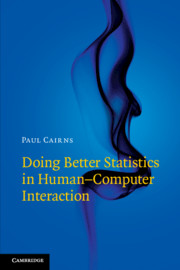Book contents
- Frontmatter
- Dedication
- Contents
- Figures
- Tables
- Acknowledgements
- Getting Started
- Part I Why We Use Statistics
- Part II How to Use Statistics
- 5 Planning Your Statistical Analysis
- 6 A Cautionary Tail: Why You Should Not Do a One-Tailed Test
- 7 Is This Normal?
- 8 Sorting Out Outliers
- 9 Power and Two Types of Error
- 10 Using Non-Parametric Tests
- 11 A Robust t-Test
- 12 The ANOVA Family and Friends
- 13 Exploring, Over-Testing and Fishing
- 14 When Is a Correlation Not a Correlation?
- 15 What Makes a Good Likert Item?
- 16 The Meaning of Factors
- 17 Unreliable Reliability: The Problem of Cronbach’s Alpha
- 18 Tests for Questionnaires
- Index
18 - Tests for Questionnaires
from Part II - How to Use Statistics
Published online by Cambridge University Press: 26 January 2019
- Frontmatter
- Dedication
- Contents
- Figures
- Tables
- Acknowledgements
- Getting Started
- Part I Why We Use Statistics
- Part II How to Use Statistics
- 5 Planning Your Statistical Analysis
- 6 A Cautionary Tail: Why You Should Not Do a One-Tailed Test
- 7 Is This Normal?
- 8 Sorting Out Outliers
- 9 Power and Two Types of Error
- 10 Using Non-Parametric Tests
- 11 A Robust t-Test
- 12 The ANOVA Family and Friends
- 13 Exploring, Over-Testing and Fishing
- 14 When Is a Correlation Not a Correlation?
- 15 What Makes a Good Likert Item?
- 16 The Meaning of Factors
- 17 Unreliable Reliability: The Problem of Cronbach’s Alpha
- 18 Tests for Questionnaires
- Index
Summary
Likert items and questionnaires are widely used in HCI, particularly to measure user experience. However, there is some confusion over which is the right test to use to analyse data arising from these instruments. Furthermore, this book has proposed several more modern alternatives to traditional statistical tests but there is little evidence if they are better in the context of this particular sort of data. This chapter therefore reports on several simulation studies to compare the variety of tests that can be used to analyse Likert item and questionnaire data. The results suggest that this sort of data best reveals dominance effects and therefore that tests of dominance are the most suitable, and most robust, tests to use.
Keywords
- Type
- Chapter
- Information
- Doing Better Statistics in Human-Computer Interaction , pp. 214 - 230Publisher: Cambridge University PressPrint publication year: 2019

